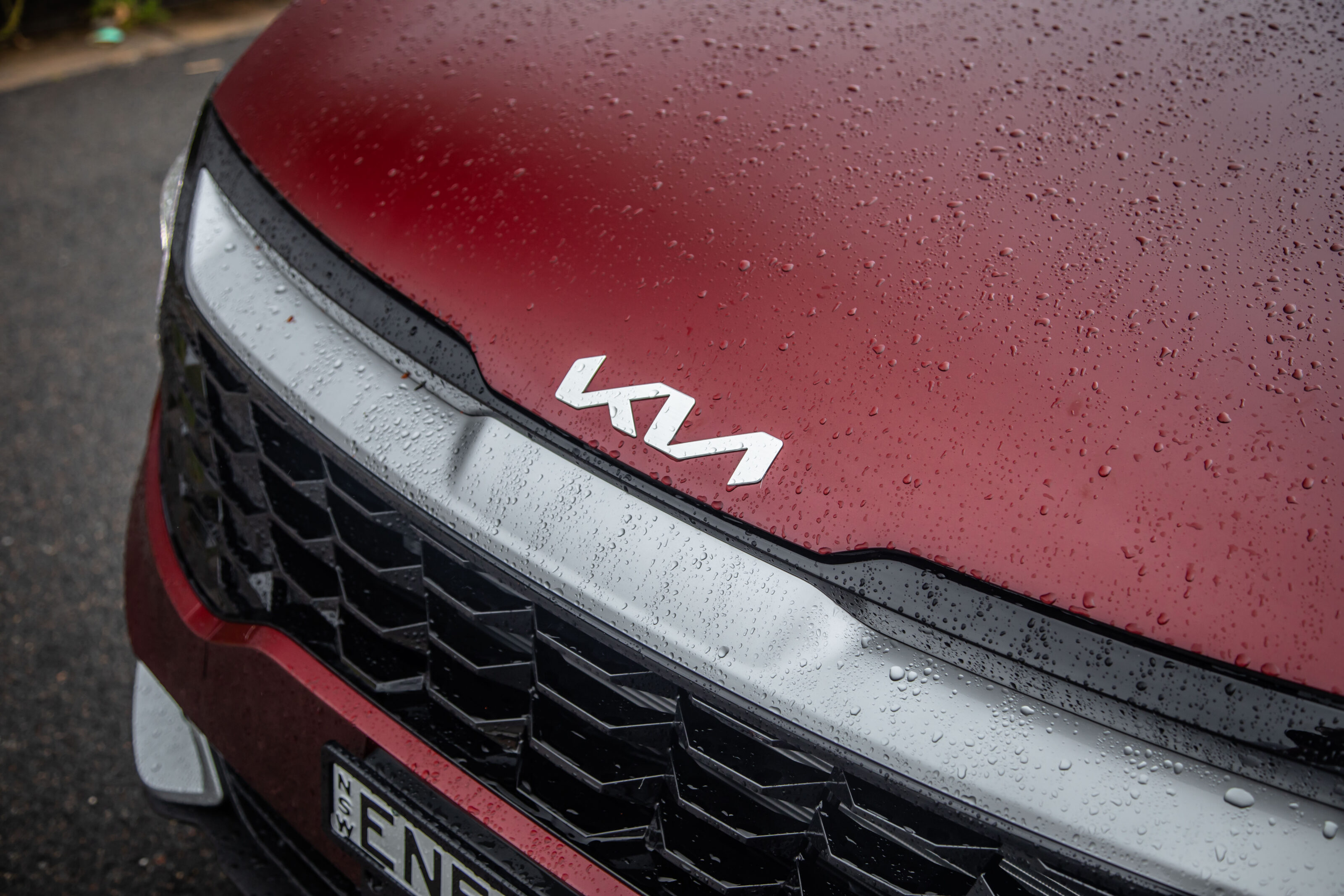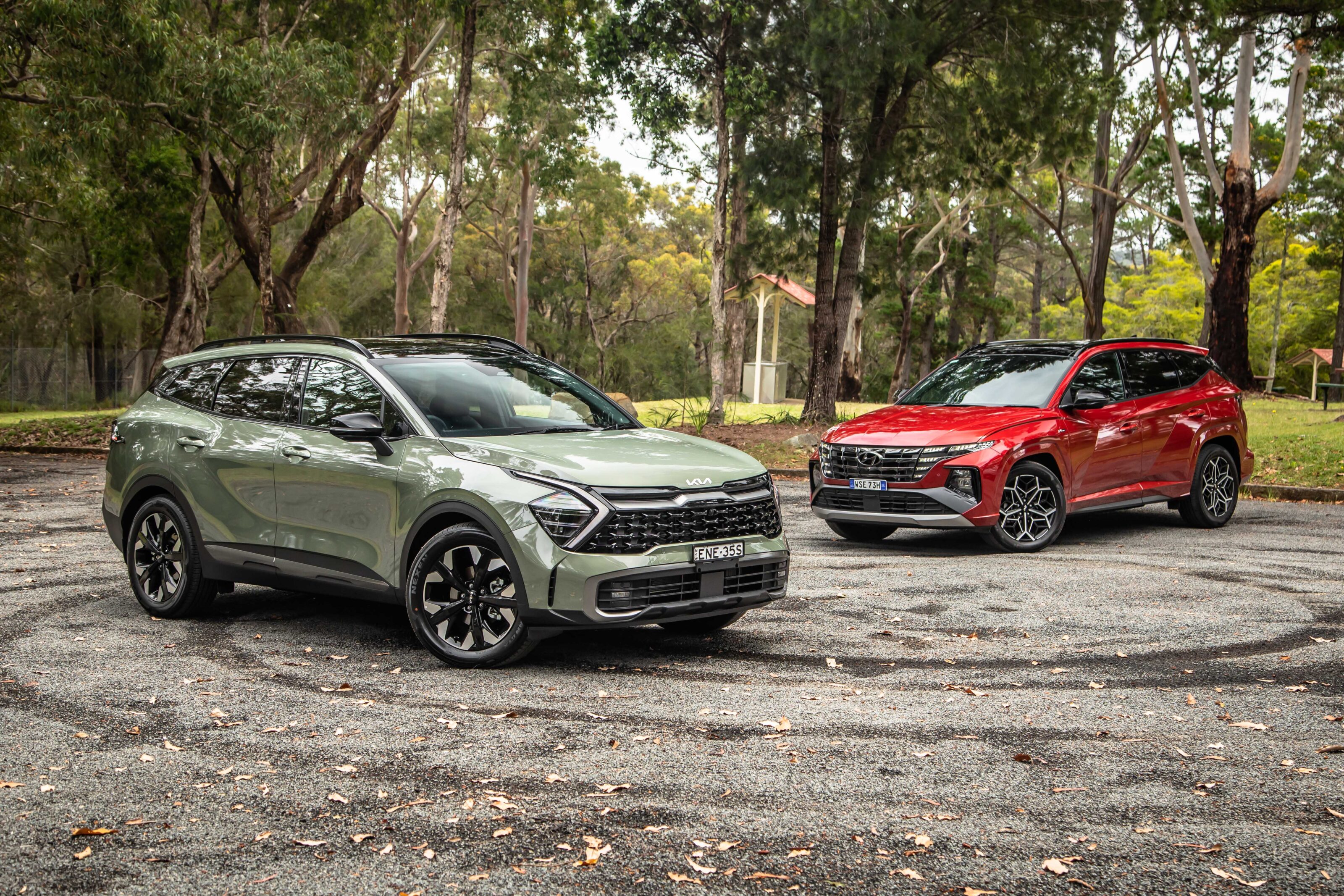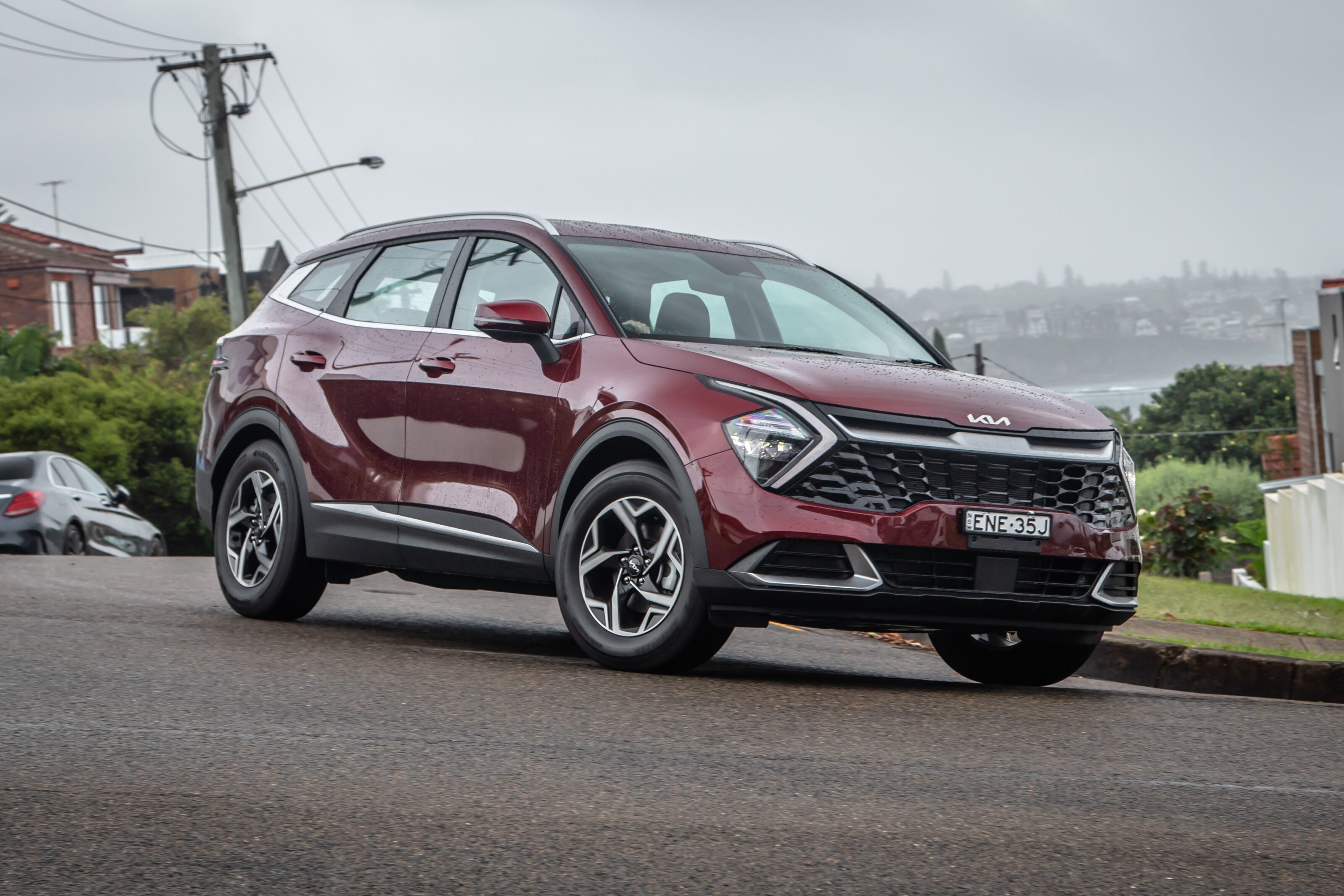Score breakdown
Things we like
- Comfortable ride
- Spacious interior
- Competitively priced
- 7-year warranty
Not so much
- Plethora of hard cabin plastics
- Underpowered engine
- Oversensitive lane-keep system
- Expensive servicing
While the world’s telcos are busy rolling out the new 5G network, there’s a fifth-generation SUV that has also been highly anticipated.
The latest Kia Sportage arrived in late 2021, bringing substantially increased exterior dimensions, bolder styling, and an enlarged equipment list across the range.
It remains a crucial model for the Korean brand. It’s the most popular Kia globally and Australia’s second-favourite Kia (after the Cerato small car), while it competes in the mid-sized SUV segment that is the country’s second-most-popular vehicle category after 4×4 utes.
We’ve already been impressed by the flagship GT-Line variant, but can the Sportage be recommended in its most affordable auto guise – the S petrol?
Pricing and Features

Car manufacturers are not in the business of giving away features, so extended equipment lists are accompanied by price increases.
Kia’s sharp drive-away pricing offer took the sting out of those initially, before disappearing in late January.
The base Sportage, with a $32,445 (before on-road costs) starting RRP, has gone from $34,690 to $36,479 drive-away for the manual 2.0L petrol front-wheel drive, or from $35,690 to $38,539 drive-away for the auto version that is more relevant to most buyers.
Customers with $39,845 ($44,101 drive-away) to spend can access an all-wheel-drive diesel drivetrain.
Some Sportage S features were previously limited to the GT-Line. These include adaptive cruise, blind-spot and rear cross-traffic monitoring systems

Some standard Sportage S features were previously limited to the range-topping GT-Line last time out. These include adaptive cruise (auto transmission only) and rear sensors linked to blind-spot and rear cross-traffic monitoring systems. There are also LED headlights, though only the new GT-Line comes with full-LED projector-style lamps.
LED tail-lights (again partial only with full LED on the GT-Line) and tyre pressure monitoring move down from the old SX+ grade.
The S also adopts an electric park brake, speed sign notification, wireless Apple CarPlay/Android Auto, multi-device Bluetooth connectivity and a front centre airbag designed to prevent a clash of heads in the event of a side impact.

It’s well-equipped, even if the kit list merely brings it up to speed with key competitors, including the two most popular mid-sized SUVs in Australia, the Toyota RAV4 and Mazda CX-5.
Rain-sensing wipers, integrated navigation, keyless start and digital radio are features found in the $34,300 RAV4 GX petrol and $33,390 CX-5 Maxx (prices before on-road costs) but not the Sportage S, while the Toyota adds front parking sensors and the Mazda provides a head-up display.
Elsewhere, a base Subaru Forester carries a slightly higher RRP of $35,990 (plus on-road costs) over the entry Sportage but provides a bigger engine, all-wheel drive, and a handful of extra features.

Within the Sportage line-up, stepping up to the SX – priced from $35,000 ($39,111 drive-away) – brings several features to easily justify the dollar gap to the S.
These include dual-zone climate control, electric lumbar adjustment for the driver’s seat, 18-inch wheels, seat-fold release levers in the boot, and a larger infotainment display (12.3 rather than 8.0 inches).
With no major options available, buyers must climb further up the grade ladder for desirable features such as an automatic tailgate, branded audio system, electric seat adjustment, wireless smartphone charging and a panoramic sunroof.
Comfort and Space

In GT-Line guise, the Sportage presents one of the best interiors in the segment. The flagship has obvious advantages such as leather upholstery and a wide, curved dual digital display, though the S’s perception of quality isn’t helped by a no-frills colour scheme, a very basic digital driver display, and front doors that are finished in harder plastic rather than the softer material used in all other grades.
Air-con is single-zone only and the S misses out on the clever digital Dual Control Panel found in other Sportages and that can be switched cleverly between infotainment and HVAC (heating, ventilation, air-conditioning).
Blank buttons on the centre console only serve to remind the owner that they’ve bought the base model, none of the windows incorporate auto up/down, and a key ignition is antiquated in this era of starter buttons (keyless start/entry isn’t standard until the SX+ variant).

Cabin ergonomics are harder to fault. Climate controls and the infotainment display are angled towards the driver, various buttons and switches are all logically positioned, and the thruster-style gear selector fits satisfyingly in an enclosed palm.
The front seats provide comfortable cushioning and good lateral support, though longer-legged occupants might prefer some extra cushion length.
This tester found the rear bench better for under-thigh support. Passengers in the back are also treated to the largest amount of space yet found in a Sportage – with an extra 8cm of legroom created courtesy of lengthened dimensions that include a wheelbase stretched by 8.5cm over the previous model.

Kia has also ensured the base model doesn’t miss out on important rear-seat features such as vents and armrest (with cup holders).
The door pockets, as with those up front, could be more generously sized, though, and the S (along with the SX) lacks the USB-C charging points found in the seatbacks of SX+ and GT-Line models.
Cabin ergonomics are harder to fault. The infotainment display is angled towards the driver, switches are all logically positioned, and the gear selector fits satisfyingly in an enclosed palm

Boot space has also benefited from the Sportage’s enlargement. Up from the old model’s 446-litre luggage capacity to a quoted 543L, the Kia now offers one of the biggest boots in its segment despite the rarity of a full-size spare wheel under the floor.
A retractable cargo blind can hide belongs, but the S misses out on remote release levers for the 60:40 rear seats (SX upwards) and a luggage net (GT-Line only).
Infotainment

The 8.0-inch media unit display doesn’t look entirely at home in its dash position, betraying its status as the budget infotainment interface of the range.
Graphics are also less fanciful than those used for the larger, 12.3-inch touchscreen employed in other variants.
At least that’s largely irrelevant for those preferring Apple CarPlay or Android Auto, and the S exclusively enables wireless connection where other grades require smartphones to be plugged. Google/Apple Map apps are also important in the absence of integrated navigation.
The 8.0-inch display doesn’t look entirely at home, betraying its status as the budget of the range. Graphics are less fanciful than those used for the touchscreen in other variants

Two smartphones can be connected simultaneously, allowing one to be charged while the other links with the display.
However, that’s the only way to recharge your smartphone as an inductive tray is exclusive to the GT-Line.
The S also lacks digital radio and comes with only a basic six-speaker audio system. An eight-speaker Harman Kardon system features on SX+ and GT-Line models.
On the Road

Kia Australia was determined to battle through the logistical challenges of the pandemic to maintain its local ride and handling program for the fifth-generation Sportage.
The team was also granted its wish to equip the SUV with Mando dampers featuring advanced valve technology, promising a sporty yet comfy ride.
While suspension compliance on the S never matches the impressive level of the GT-Line despite its smaller wheels and thicker tyres, the base Sportage provides more than adequate ride comfort.
The Sportage is also at its wieldiest in its lighter S specification, though keen drivers will still discover more involving handling in a CX-5 or Volkswagen Tiguan.

Kia Australia had to settle for a Korean-market steering tune and, while decent, it’s not quite nailed when it comes to off-centre response. However, there is a welcome consistency to the weighting once more lock is applied.
The lane-keep system is a greater frustration, its overly sensitive calibration often resulting in tugs at the steering wheel even when the vehicle is sufficiently clear of lane markings.
Carried over from the previous Sportage, the S petrol’s 2.0-litre four-cylinder lacks direct fuel injection and offers outputs of just 115kW and 192Nm, so it is neither advanced nor powerful.
While suspension compliance on the S never matches the GT-Line, the base Sportage provides more than adequate ride comfort … keen drivers will discover more involving handling in a CX-5 or Tiguan

While the six-speed auto operates with greater smarts than the seven-speed dual-clutch auto teamed with the 1.6-litre turbo-petrol engine that’s not available in the S, it can be slow to downshift to compensate for the 2.0-litre’s limited torque.
Picking the 2.0-litre turbo-diesel costs more but repays with much stronger performance and better fuel economy.
The base petrol is the thirstiest engine in the range, rated at 8.1 litres per 100km compared with 7.2L/100km for the turbo-petrol and 6.3L/100km for the diesel.
Braked towing capacity is 1900kg for the diesel and manual 2.0L petrol, or 1650kg for the auto 2.0L petrol and 1.6L turbo.
Ownership

The Sportage is covered by Kia’s renowned seven-year warranty but the brand’s capped-price servicing program isn’t quite as generous. Costing $1280 over three years, $2395 over five years or $3479 over seven years, dealership maintenance costs for the Sportage are higher than average.
Its twin-under-the-skin Hyundai Tucson is surprisingly cheaper to service, along with the aforementioned rivals the Mazda CX-5 and (especially inexpensive) Toyota RAV4.
VERDICT

The fifth-generation Kia Sportage is a bigger, safer and better proposition than its predecessors. As with many of its rivals, it’s just more convincing in higher specifications.
It’s well worth the relatively small price jump to the SX variant, or even consider Kia’s smaller Seltos Sport Plus that is sufficiently roomy for small families and, for virtually the same money, provides some extra features, a turbo-petrol engine and all-wheel drive.
2022 Kia Sportage S specifications
| Body | 5-door SUV |
|---|---|
| Drive | FWD |
| Engine | 2.0-litre four-cylinder |
| Transmission | 6-speed auto |
| Power | 115W @ 6200rpm |
| Torque | 192Nm @ 4500rpm |
| Bore stroke (mm) | 81.0 x 97.0 |
| Compression ratio | 10.8: 1 |
| 0-100km/h | Not quoted |
| Fuel consumption | 8.1L/100km (auto, combined) |
| Weight | 1538kg |
| Suspension | Struts (front); multi-links (rear) |
| L/W/H | 4660/1865/1680mm |
| Wheelbase | 2755mm |
| Brakes | 305mm ventilated discs (front); 300mm solid discs (rear) |
| Tyres | Hankook Dynapro HP2 235/65R17 |
| Wheels | 17-inch alloy (full-size spare) |
| Price | $34,445 + on-road costs / $35,690 drive-away |
Score breakdown
Things we like
- Comfortable ride
- Spacious interior
- Competitively priced
- 7-year warranty
Not so much
- Plethora of hard cabin plastics
- Underpowered engine
- Oversensitive lane-keep system
- Expensive servicing
We recommend
-
 Comparisons
Comparisons2022 Kia Sportage vs Hyundai Tucson comparison review
The two Korean giants have both released striking new mid-size SUVs to combat the ongoing threat from Europe, Japan and now China. Which of these two is for you?
-
 Reviews
ReviewsLiving with the 2022 Kia Sportage GT-Line 2.0 diesel AWD
More! The 2022 Sportage is more spacious, more advanced and a more premium offering than before, but is it enough to beat the best in the segment?
-
 News
News2022 Kia Sportage drive-away price increased
Changes to the Sportage's drive-away pricing take away its competitive edge






